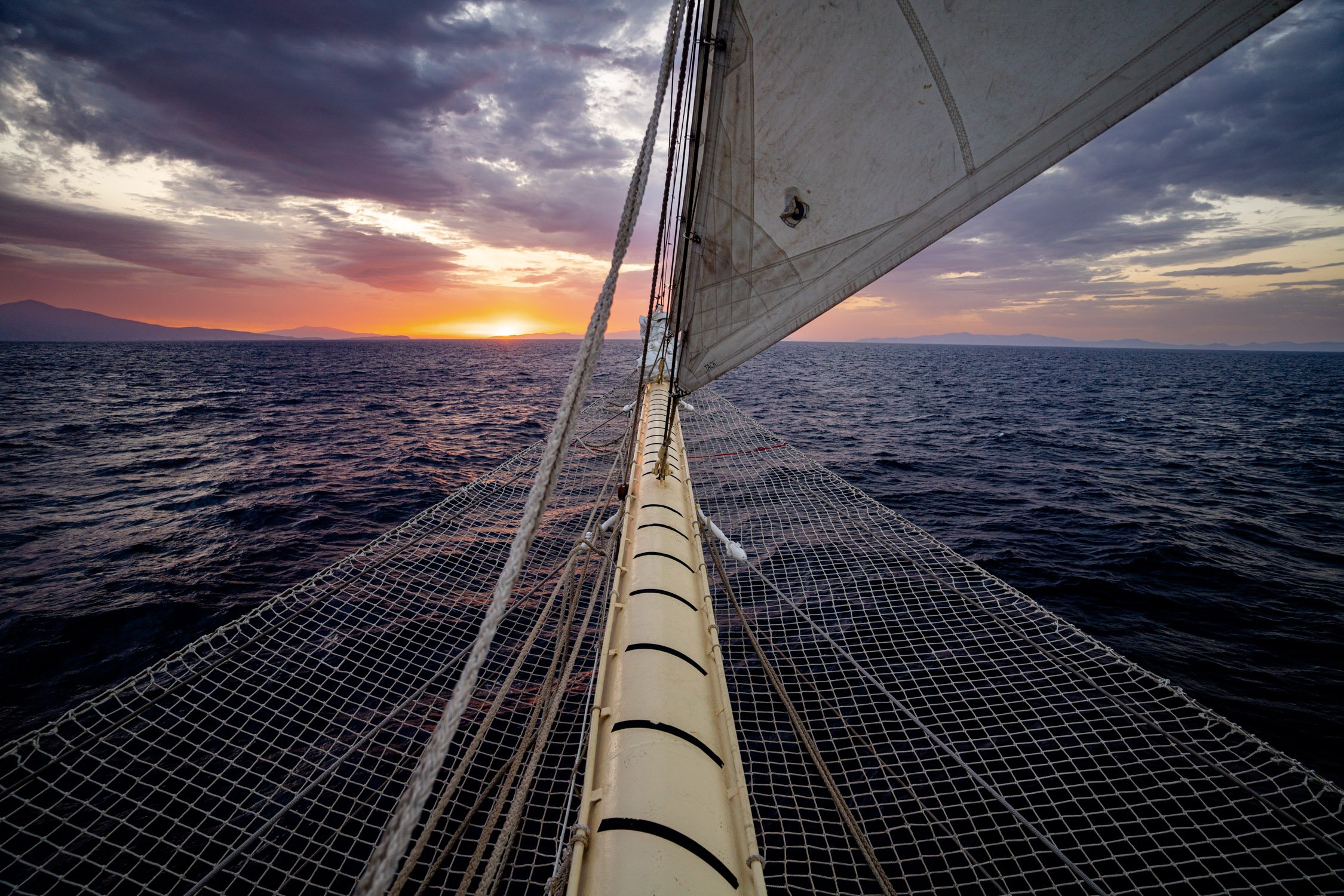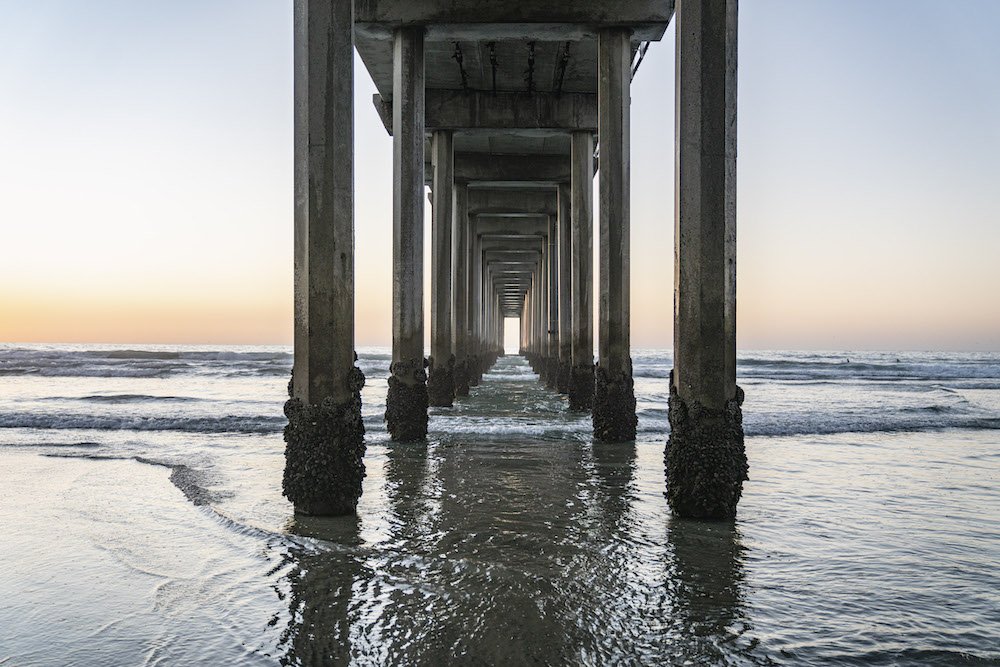Exploring the Greek Islands by Sailboat
Sailing the Greek islands offers a unique and enchanting way to experience Greece's rich history, stunning landscapes, and vibrant culture. With a myriad of islands scattered across the Aegean and Ionian Seas, each boasting its own distinct charm, a sailboat vacation provides the flexibility to explore hidden coves, picturesque villages, and ancient ruins at your own pace. Here’s a guide to help you plan the perfect sailing adventure in the Greek islands.
Watching the sunrise from the bow of the sailboat in the Aegean Sea while sailin around the Greek Islands. Photo by Dalton Johnson
Pros:
Scenic Beauty: The Greek islands offer breathtaking scenery, from crystal-clear waters and sandy beaches to dramatic cliffs and charming villages. Sailing allows you to witness these landscapes from unique vantage points and discover hidden gems inaccessible by land.
Flexibility and Freedom: Sailing gives you the freedom to create your own itinerary and explore at your own pace. You can visit multiple islands, anchor in secluded bays, and change your plans on the fly, making for a highly personalized and adventurous vacation.
Rich Cultural Experiences: Each Greek island has its own unique history, culture, and traditions. Sailing allows you to immerse yourself in the local way of life, visit ancient ruins, participate in festivals, and enjoy authentic Greek cuisine in picturesque settings.
Ideal Sailing Conditions: The Greek islands boast favorable sailing conditions, particularly from late spring to early autumn. The warm Mediterranean climate, steady winds, and calm seas make for enjoyable and safe sailing experiences, suitable for both novice and experienced sailors.
Variety of Islands: The Greek islands are diverse, with each island group offering distinct experiences. From the cosmopolitan vibe of Mykonos to the tranquil beauty of the Ionian islands, sailing allows you to experience a wide variety of destinations within a single trip.
Cons:
Weather Variability: While the weather is generally favorable, the Meltemi winds in the Aegean Sea can be quite strong during the summer months, which can be challenging for less experienced sailors. Sudden weather changes can also impact sailing plans.
Crowds in Peak Season: Popular islands like Mykonos and Santorini can become very crowded during the peak tourist season (July and August). This can lead to busy harbors, limited docking space, and higher prices for mooring, dining, and attractions.
Logistical Challenges: Sailing requires careful planning and navigation. Ensuring your sailboat is well-equipped, managing provisions, and dealing with technical issues can be challenging, especially for those new to sailing. Chartering a boat can also be expensive.
Limited Onshore Time: While sailing provides flexibility, it also means you might have limited time to explore each island in-depth. Frequent sailing to different destinations can reduce the time available for onshore activities, sightseeing, and relaxation.
Seasickness and Comfort: Seasickness can be an issue for some travelers, potentially affecting the enjoyment of the trip. Additionally, sailboats have limited space and amenities compared to hotels, which might not be as comfortable for everyone, especially on longer voyages.
Why Choose Sailing in the Greek Islands?
The Greek islands are a sailor's paradise. With over 6,000 islands and islets, only 227 of which are inhabited, there are endless opportunities for discovery. Sailing allows you to visit secluded beaches, dive into crystal-clear waters, and dock at charming port towns, all while enjoying the freedom and serenity that comes with being on the open sea.
Moreover, the Mediterranean climate ensures plenty of sunshine and warm temperatures, creating ideal conditions for sailing. The Greek islands also offer a rich tapestry of experiences, from bustling nightlife and gourmet dining to quiet, unspoiled natural beauty and historical landmarks.
When to Visit the Greek Islands
The best time to visit the Greek islands for a sailing trip is from late April to early October. During this period, the weather is warm, the sea is calm, and the winds are favorable for sailing.
Spring (April to June): This is an excellent time for sailing, with mild temperatures, blooming landscapes, and fewer tourists. The winds are generally calm, making it perfect for those who prefer a more relaxed sailing experience.
Summer (July to August): The peak tourist season, characterized by hot temperatures and bustling islands. The Meltemi winds in the Aegean Sea can be strong, providing exhilarating sailing conditions for experienced sailors. However, popular islands can be crowded.
Autumn (September to October): Another ideal time to visit, with warm sea temperatures and fewer crowds. The weather remains pleasant, and the winds are moderate, making it suitable for all sailing skill levels.
Planning Your Sailing Route
The Greek islands are divided into several groups, each offering a distinct experience. Here are some popular routes to consider:
The Cyclades: Known for their iconic white-washed buildings and blue-domed churches, the Cyclades include famous islands like Mykonos, Santorini, and Paros. This group is perfect for those seeking a mix of vibrant nightlife, historic sites, and stunning scenery. The winds can be strong, especially during the Meltemi season, so it's ideal for more experienced sailors.
The Ionian Islands: Located on the western side of Greece, these islands, including Corfu, Zakynthos, and Kefalonia, are known for their lush green landscapes and calm waters. This area is suitable for all sailing levels and is great for family vacations, with plenty of sheltered bays and picturesque harbors.
The Dodecanese: Situated near the Turkish coast, the Dodecanese islands offer a mix of medieval architecture, vibrant culture, and beautiful beaches. Islands like Rhodes, Kos, and Patmos are rich in history and offer a more laid-back atmosphere compared to the bustling Cyclades.
The Saronic Gulf: Close to Athens, this group includes islands like Aegina, Poros, and Hydra. It's an excellent choice for shorter trips or for combining a sailing adventure with a visit to the mainland. The distances between islands are short, making it ideal for less experienced sailors.
Essentials for a Greek Sailing Adventure
Charter Options: You can choose between a bareboat charter (where you sail the boat yourself) or a skippered charter (where a professional skipper handles the sailing). For those new to sailing, a skippered charter is recommended.
Packing Tips: Bring lightweight clothing, swimwear, sun protection (sunscreen, hats, sunglasses), and non-slip shoes. Don’t forget a light jacket for cooler evenings.
Safety First: Ensure your sailboat is equipped with essential safety gear, including life vests, first aid kits, and navigation equipment. Familiarize yourself with local sailing regulations and weather patterns.
Experiencing Greek Island Culture
While sailing the Greek islands, take the time to immerse yourself in the local culture. Visit ancient ruins, explore charming villages, and indulge in delicious Greek cuisine. Each island has its own specialties, from fresh seafood and traditional mezes to local wines and spirits.
Engage with the locals, who are known for their warm hospitality. Participate in local festivals and traditions to get a deeper understanding of the rich cultural heritage that each island holds.
Taking in the view from the windmills on Mykonos Island in Greece. Photo by Dalton Johnson
A sailing trip around the Greek islands promises an unforgettable vacation filled with adventure, relaxation, and cultural enrichment. Whether you're navigating the vibrant Cyclades, the serene Ionian islands, or the historical Dodecanese, the beauty and diversity of the Greek islands will leave you with lasting memories. Plan your voyage, set sail, and let the magic of Greece unfold before you.










